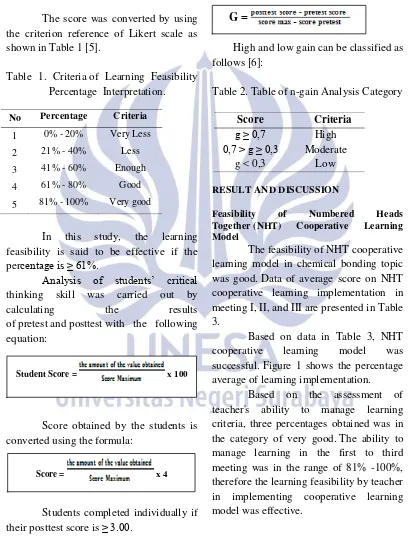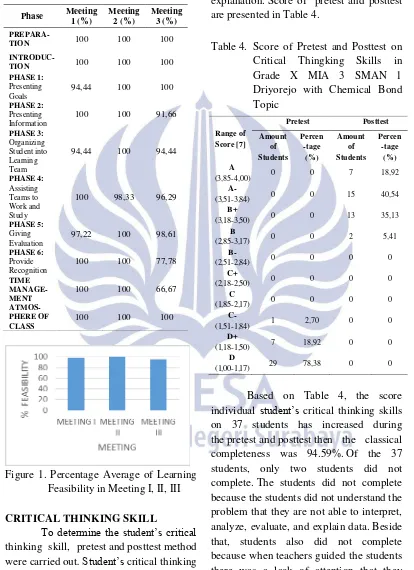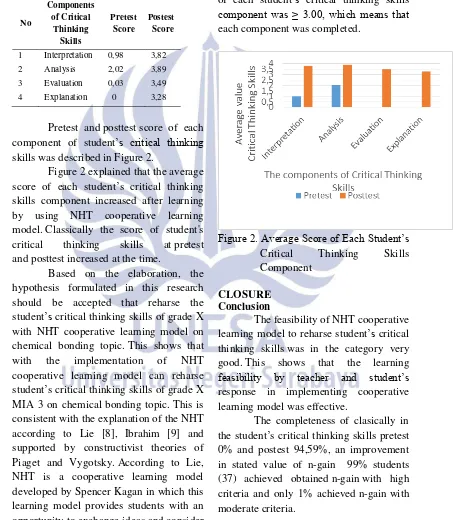UNESA Journal of Chemical Education ISSN: 2252-9454 Vol. 5 No. 2, pp. 232-238 May 2016
IMPLEMENTATION OF NUMBERED HEADS TOGETHER (NHT) COOPERATIVE LEARNING MODEL IN CHEMICAL BONDING TOPIC TO REHARSE THE STUDENT’S CRITICAL THINKING
SKILLS IN GRADE X SMAN 1 DRIYOREJO
Amilia Rizky Ichwani and Dian Novita
Departemen of Chemistry, Faculty of Mathematics and Natural Sciences State University of Surabaya
Jl. Ketintang Surabaya (60231), Telp. 031-8298761 Mobile Phone: 085755209153, e-mail: [email protected]
Abstrak
Penelitian ini dilakukan untuk mengetahui keterlaksanaan model pembelajaran kooperatif tipe NHT dan peningkatan keterampilan berpikir kritis siswa setelah penerapan model pembelajaran kooperatif tipe NHT kelas X SMAN 1 Driyorejo. Rancangan penelitian yang digunakan adalah One Group Pretest Posttest Design, yaitu eksperimen yang dilaksanakan pada satu kelompok saja tanpa kelompok pembanding. Metode penelitian yang digunakan adalah 1) Metode observasi berupa observasi keterlaksanaan model pembelajaran kooperatif tipe NHT dan 2) Metode tes berupa tes keterampilan berpikir kritis (essay). Hasil penelitian menunjukan bahwa: 1) Persentase rata-rata keterlaksanaan model pembelajaran kooperatif tipe NHT pada pertemuan 1 sebesar 98,34 % (sangat baik), pertemuan 2 sebesar 100 % (sangat baik), dan pertemuan 3 sebesar 95,28 % (sangat baik). Keterlaksanaan model pembelajaran kooperatif tipe NHT efektif dikarenakan persentase rata-rata kualitas keterlakasanaan model pembelajaran kooperatif tipe NHT dalam kriteria sangat baik. 2) Keterampilan berpikir kritis siswa mengalami ketuntasan klasikal untuk pretest sebesar 0% dan posttest sebesar 94,59%, peningkatan dinyatakan dengan nilai n-gain sebesar 99% dari 37 siswa mendapatkan n-gain dengan kriteria tinggi dan 1% mendapatkan n-gain dengan kriteria sedang. Dengan demikian dapat disimpulkan bahwa penerapan model pembelajaran kooperatif tipe NHT pada materi pokok ikatan kimia dapat melatih keterampilan berpikir kritis siswa kelas X SMAN 1 Driyorejo.
Kata kumci: model pembelajaran kooperatif tipe NHT, keterampilan berpikir kritis, ikatan kimia
Abstract
This study was conducted to determine the feasibility of NHT cooperative learning model and improvement student’s critical thinking skills after the implementation of NHT cooperative learning model in grade X SMAN 1 Driyorejo. The research design used one group pretest posttest design, the experiment was carried out on a single group without comparison group. The method used were 1) An observation method was observation of NHT cooperative learning model feasibility and 2) The test method of critical thinking skills (essay). The results showed that: 1) The average percentage NHT cooperative learning model implementation in the first meeting was 98.34% (excellent), second meeting was 100% (excellent), and the third meeting was 95.28% (very good). NHT cooperative learning model implementation was effective as the implementation quality average percentage of NHT cooperative learning model was in very good criteria. 2)the completeness of clasically in the student’s critical thinking skills pretest 0% and postest 94,59%, an improvement in stated value of n-gain 99% students (37) achieved obtained n-gain with high criteria and only 1% achieved n-gain with moderate criteria. It can be concluded that the application of NHT cooperative learning model in chemical bond topic can reharse student’s critical thinking skills of grade X SMAN 1 Driyorejo.
UNESA Journal of Chemical Education ISSN: 2252-9454 Vol. 5 No. 2, pp. 232-238 May 2016
INTRODUCTION
The education field in Indonesia now is growing in improve quality. In 2013, the government imposed Curriculum 2013 (Kurikulum 2013) replacing Kurikulum Tingkat Satuan Pendidikan (KTSP) or School Based Curriculum (SBC) to improve not only student’s cognitive aspects but also affective and psychomotor of students as well as balancing the three. In Curriculum 2013, students are required to be more active and independent in searching information and solving problems, therefore, learning is not teacher-centered but student-centered.
The Characteristic of Curriculum 2013 is to develop attitudes, knowledges, and skills then apply them in various situations in schools and communities [1]. In addition, in Curriculum 2013, the forth Main Competence measures student’s progress from skills aspects [1]. The nature of chemistry includes two things, chemistry as chemical products and as process [2]. Chemical as product includes a set of knowledge that consists of facts,
concepts, and principles of
chemistry. Chemistry as process covers the skills and attitudes possessed by scientists to obtain and develop chemical knowledge. These skills are called process skills, while the attitudes possessed by scientists is called scientific attitude.
Chemistry is a branch of science which is important and can be used to understand what is happening around us. Chemistry subjects in Senior High School covers everything about substance that covers the composition, structure and properties, changes, dynamics and energetics of substances that involve skills and reasoning. Chemists was studied natural phenomena through processes and scientific attitude. The example of process
are observations and experiments, while the example scientific attitude are objective and honest when collecting and analyzing data. By using the process and the scientific attitude, chemists was obtained a facts, theories, laws, and principles. These discoveries are called chemical products. Therefore, the learning of chemistry and chemistry assessment of chemistry learning outcomes should consider the characteristics of chemistry as attitudes, processes, and products.
Chemical bonding is one of topics in semester 1 of grade X. The chemical bonding is about the process of ionic bonding formation, covalent bond, coordination covalent bond and metallic bond as well as interaction between particles (atoms, ions, molecules) of material. There are a lot of symbols in chemical bonding to describe the structure of lewis. Therefore, students often have difficulty in understanding the concept of chemical bond that is presented by the teacher with use demonstration or lecture methods. Therefore, it is better if students can obtain their own concepts to be learned. One of way to obtain the concepts with discussing between friends through NHT cooperative learning model.
UNESA Journal of Chemical Education ISSN: 2252-9454 Vol. 5 No. 2, pp. 232-238 May 2016
reharse the students to talk with each other seriously and share ideas as students attempt to obtain a variety of information so that everyone knows for sure the answer has been discussed [3].
To prepare Indonesia society in order that have the ability to live as individuals and citizens who believe, productive, creative, innovative, affective and able to contribute to the society, nation, state, and civilization of the world, the skill of critical thinking is used to achieve the purpose of kurikulum 2013. According to Beyer (1995), critical thinking is a disciplined way of thinking used by someone to evaluate the validity of something (statements, ideas, arguments, research, etc.). Teacher is the main role in reharsing critical thinking skills by conditioning the learning activities in which the students are able to develop their thinking skills. According to Facione, there are six major critical thinking skills involved in critical thinking process. The skills are interpretation, analysis, evaluation, inference, explanation, and self-regulation [4]. The six skills are used to reharse critical thinking skills.
Based on the elaboration above, a research entitled "Implementation of Numbered Heads Together (NHT) Cooperative Learning Model in Chemical Bonding Topic to Reharse the Student’s Critical Thinking Skills in Grade X SMAN 1 Driyorejo" was conducted.
RESEARCH METHODS
In this study, the research design used was one group pretest posttest design, the experiments were carried out on a single group without a comparison group.
Where:
O1 = initial tests (pretest).
X = treatment of NHT cooperative learning model
O2 = final test (posttest).
Analysis: calculating significance (O2 - O1)
The subject of this research was students of grade X SMAN 1 Gresik Driyorejo. The sample was randomly selected from the population of grade X. This research was conducted at SMAN 1 Gresik Driyrejo in the first semester of the year 2015-2016. The instrument used for this study was the observation sheets of learning feasibility and student worksheets to measure student’s critical thinking skills after NHT cooperative learning model was implemented. The procedure of the research was conducted through three stages there are planning, implementation, and analyzing data. The learning device used was a syllaby and Lesson Plan (RPP). Technique of data collection was observation and test method. Technique of data analysis of learning feasibility and analysis of student’s critical thinking skill.
The purpose of data analysis in learning feasibility to determine the quality of learning feasibility conducted by the teacher. Calculation of learning feasibility quality in every learning process is carried out in the following ways:
O1 X O2
UNESA Journal of Chemical Education ISSN: 2252-9454 Vol. 5 No. 2, pp. 232-238 May 2016
Where:
P = percentage
Criterion score = highest score for each aspect observed x the
number of aspects
observed.
The score was converted by using the criterion reference of Likert scale as shown in Table 1 [5].
Table 1. Criteria of Learning Feasibility Percentage Interpretation.
In this study, the learning feasibility is said to be effective if the percentage is ≥ 61%.
Analysis of students’ critical thinking skill was carried out by
calculating the results
of pretest and posttest with the following equation:
Score obtained by the students is converted using the formula:
Students completed individually if their posttest score is ≥ 3.00.
The increasing of student’s critical thinking skills after the implementation NHT cooperative learning model was determined by n-gain. The formula to determine the value of n-gain is as follows:
High and low gain can be classified as follows [6]:
Table 2. Table of n-gain Analysis Category
RESULT AND DISCUSSION
Feasibility of Numbered Heads Together (NHT) Cooperative Learning Model
The feasibility of NHT cooperative learning model in chemical bonding topic was good. Data of average score on NHT cooperative learning implementation in meeting I, II, and III are presented in Table 3.
Based on data in Table 3, NHT cooperative learning model was successful. Figure 1 shows the percentage average of learning implementation.
Based on the assessment of teacher's ability to manage learning criteria, three percentages obtained was in the category of very good. The ability to manage learning in the first to third meeting was in the range of 81% -100%, therefore the learning feasibility by teacher in implementing cooperative learning model was effective.
No Percentage Criteria
1 0% - 20% Very Less
2 21% - 40% Less
3 41% - 60% Enough
4 61% - 80% Good
5 81% - 100% Very good
Score Criteria
g ≥ 0,7 High
0,7 > g ≥ 0,3 Moderate
g < 0,3 Low
Student Score = x 100
Score = x 4
UNESA Journal of Chemical Education ISSN: 2252-9454 Vol. 5 No. 2, pp. 232-238 May 2016
Table 3. Data of Average Score on NHT Cooperative Learning Feasibility in Chemical Bonding Topic.
Figure 1. Percentage Average of Learning Feasibility in Meeting I, II, III
CRITICAL THINKING SKILL
To determine the student’s critical thinking skill, pretest and posttest method were carried out. Student’scritical thinking ability was measured through a test that
includes questions on the components of critical thinking there are interpretation,
analysis, evaluation, and
explanation. Score of pretest and posttest are presented in Table 4.
Table 4. Score of Pretest and Posttest on Critical Thingking Skills in Grade X MIA 3 SMAN 1 Driyorejo with Chemical Bond Topic
Based on Table 4, the score individual student’s critical thinking skills on 37 students has increased during the pretest and posttest then the classical completeness was 94.59%. Of the 37 students, only two students did not complete. The students did not complete because the students did not understand the problem that they are not able to interpret, analyze, evaluate, and explain data. Beside that, students also did not complete because when teachers guided the students there was a lack of attention that they missed a lot of stuffs. Below is the score of
UNESA Journal of Chemical Education ISSN: 2252-9454 Vol. 5 No. 2, pp. 232-238 May 2016
each student’s critical thinking skills components according to Facione there are interpretation, analysis, evaluation, and explanation.
Table 5. List of Each Student’s Critical Thinking Skills Component
Pretest and posttest score of each component of student’s critical thinking skills was described in Figure 2.
Figure 2 explained that the average score of each student’s critical thinking skills component increased after learning by using NHT cooperative learning model. Classically the score of student's critical thinking skills at pretest and posttest increased at the time.
Based on the elaboration, the hypothesis formulated in this research should be accepted that reharse the student’s critical thinking skills of grade X with NHT cooperative learning model on chemical bonding topic. This shows that with the implementation of NHT cooperative learning model can reharse student’s critical thinking skills of grade X MIA 3 on chemical bonding topic. This is consistent with the explanation of the NHT according to Lie [8], Ibrahim [9] and supported by constructivist theories of Piaget and Vygotsky. According to Lie, NHT is a cooperative learning model developed by Spencer Kagan in which this learning model provides students with an opportunity to exchange ideas and consider
the right answer [8]. NHT can be used to check students' understanding of the subject by involving more students studying the material covered so as to improve the mastery of academic and thinking skills.
Based on Figure 2, average score of each student’s critical thinking skills component was ≥ 3.00, which means that each component was completed.
Figure 2. Average Score of Each Student’s Critical Thinking Skills Component
CLOSURE Conclusion
The feasibility of NHT cooperative learning model to reharse student’s critical thinking skills was in the category very good. This shows that the learning feasibility by teacher and student’s response in implementing cooperative learning model was effective.
The completeness of clasically in the student’s critical thinking skills pretest 0% and postest 94,59%, an improvement in stated value of n-gain 99% students (37) achieved obtained n-gain with high criteria and only 1% achieved n-gain with moderate criteria.
No
Components of Critical
Thinking Skills
Pretest Score
Postest Score
UNESA Journal of Chemical Education ISSN: 2252-9454 Vol. 5 No. 2, pp. 232-238 May 2016
Suggestion
Time allocation and good classroom management must be considered so that the learning process by using NHT cooperative learning model can run smoothly. The ability of teachers to control student activity is very important that the learning process can be completed on time.
REFFERENCES
1. Permendikbud No. 69 Tahun 2013. (Online) (http://pendidikan- diy.go.id/file/mendiknas/kurikulum- 2013-kompetensi-dasar-sma-ver-3-3-2013.pdf), diakses 24 April 2015.
2. Susiwi. 2007. Pendekatan
Pembelajaran dalam Pembelajaran Kimia. Jakarta: Universitas Pendidikan Indonesia. (Online), (http://file.upi.edu/Direktori/FPMIPA /JUR._PEND._KIMIA/19510919198
0032-SUSIWI/SUSIWI-26)._HANDOUT_PENDEKATAN_ PEMBELAJARAN.pdf), diakses 23 April 2015.
3. Nur, Mohamad. 2011. Model Pembelajaran Kooperatif. Surabaya: Pusat SAINS dan Matematika Sekolah.
4. Filsaime, Dennis K. 2008. Menguak Rahasia Berpikir Kritis dan Kreatif. Jakarta: Prestasi Pustakaraya.
5. Riduwan. 2011. Skala Pengukuran Variabel-Variabel Penelitian. Bandung: Alfabeta.
6. Hake. 1998. Interactive Engagement Method in Introductory Mechanics Course. Department of Physics, Indiana University, (Online), (www.physics.indiana.edu/~sdi/IEM-2b.pdf), diakses 15 Januari 2016.
7. Permendikbud No.104 Tahun 2014. (Online), (http://pgsd.uad.ac.id/wp-
content/uploads/lampiran- permendikbud-n0-104-tahun-2014.pdf), diakses 17 Mei 2015.
8. Anita Lie. 2002. Cooperative
Learning (Mempraktikkan
Cooperative Learning di Ruang-Ruang Kelas). Jakarta: PT Gramedia Widiasarana.
9. Ibrahim, Muslimin. 2000.


